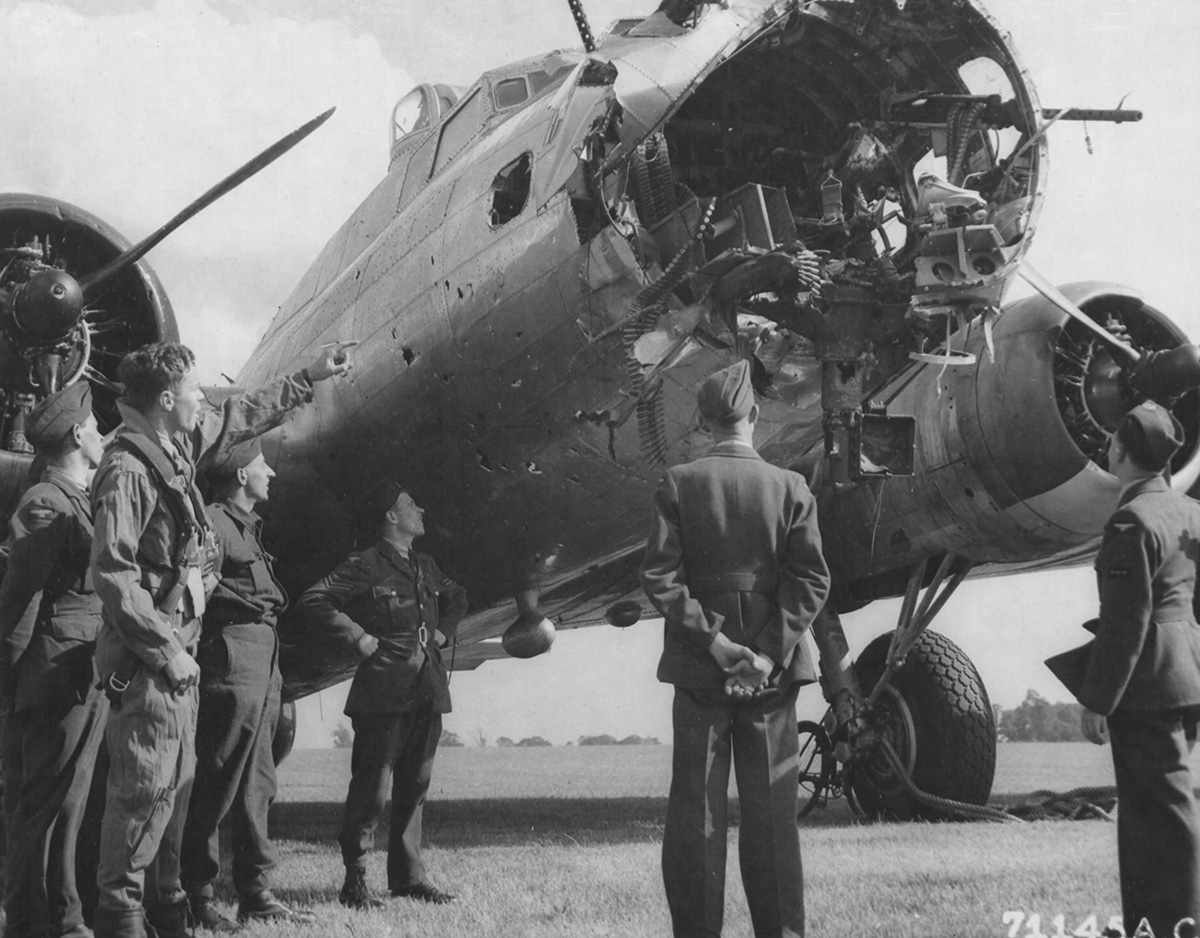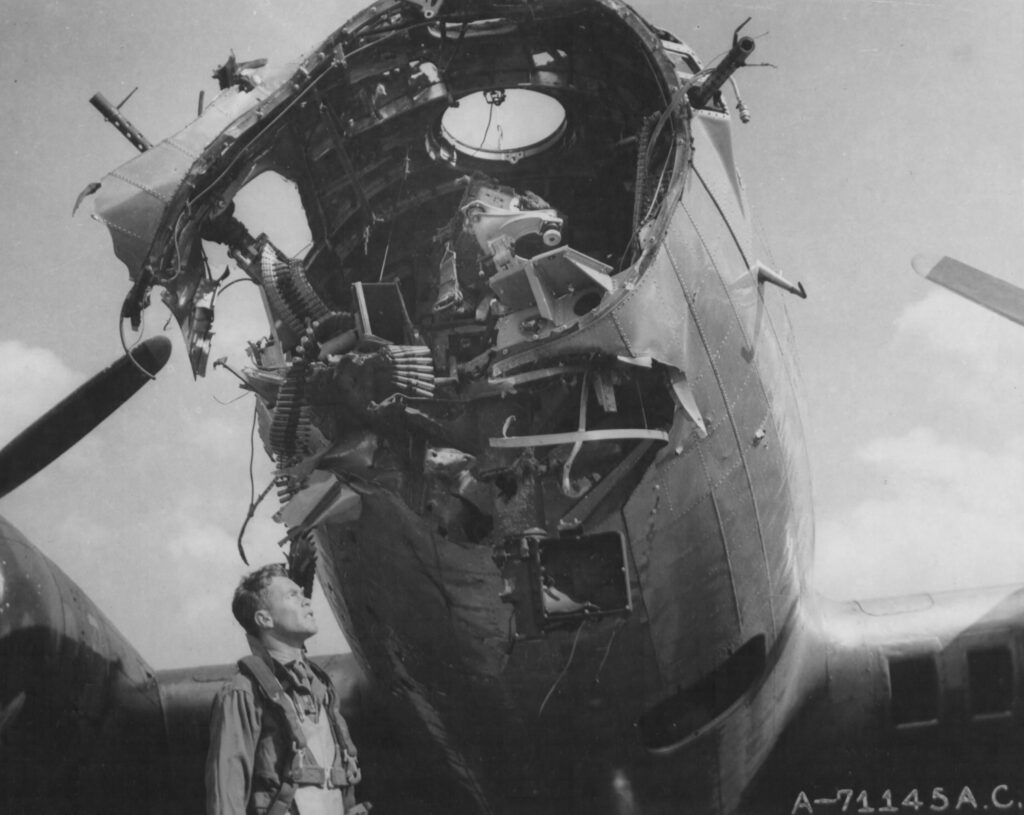 zoom_in
zoom_in
Source:
www.fold3.com
Production-block:
B-17G-35-VE: 42-97836 to 42-97935
Manufacturer:
Lockheed/Vega
- Bomb Group:
- 379th Bomb Group
- Bomb Squadron:
- 524th Bomb Squadron
- RCL: WA-U
MACR: 9364
History of
B-17 42-97890 / L’il Satan aka Queen of Hearts
Delivered Tulsa 27/3/44; Kearney 22/5/44; Grenier 29/5/44; Assigned 524BS/379BG [WA-U] Kimbolton 12/6/44 LIL SATAN; returning from Toulouse flak hit blew off nose 28/6/44 with Karl Becker; Navigator: Bob Evans, Bombardier: Arthur Maataa (2 Killed in Action); Waist gunner: Joe Simoncini (Prisoner of War), force landed RAF Hunsdon, Herts; Missing in Action Magdeburg 28/9/44 with Chas Rutledge, Navigator: Stan Pain (2 Killed in Action); Co-pilot: Tom Martin, Bombardier: Dave Anderson, Flight engineer/top turret gunner: Doyle Poling, Radio Operator: Ellis Pierson, Ball turret gunner: Cliff Rondou, Waist gunner: Arthur Green,Tail gunner: Kyle Brown (7 Prisoner of War); flak, crashed Niederndodeleben, W of Magdeberg, Ger; Missing Air Crew Report 9364. LIL SATAN aka QUEEN OF HEARTS.
Last updated: 19. February 2024
B-17 42-97890 / L’il Satan aka Queen of Hearts Details
Flak hit blew off nose on 25 June 1944. Navigator: Bob Evans, Bombardier: Arthur Maataa – 2 Killed in Action; Waist gunner: Joe Simoncini – Prisoner of War, force landed RAF Hunsdon, Herts. #42-97890 finally lost on 28. September 1944.
Crew on 25 June 1944
1Lt. Karl E. Becker – Pilot
2Lt. Patrick D. Rawls – Co-Pilot
2Lt. Robert W. Evans, Jr – Navigator (KIA)
2Lt. Arthur M. Maatta – Bombardier (KIA)
T/Sgt. Robert A. Smith – Radio Operator
T/Sgt. George M. Brittain – Engineer
S/Sgt. James A. Lalonde – Ball Turret Gunner
S/Sgt. Francis J. Phillips – Waist Gunner
S/Sgt. Joseph Simoncini – Tail Gunner (POW)
Maj. Alexander B. Andrews – Observer
Consolidated report from crew interrogation of A/C 42-97890 after mission to Coulanges Sur Yonne on 25 June 1944 – MACR 6738
Over Paris, on their way back from the target, a burst of flak hit the nose of the aircraft directly. The nose was blown completely off and the metal section was mushroomed back. The Bombardier, Lt. Maata, had most of one leg blown off, the other leg fractured, one arm fractured, and serious internal injuries. Flak continued to hit them from then on. The whole aircraft vibrated tremendously. The Navigator, somewhat hard of hearings, baled out when the Pilot gave the order to prepare bail out. The tail gunner soon followed suit.
The Pilot and Co-Pilot remained right at their controls to keep the ship in the air. In the meantime, the bombardier crawled back to the escape hatch and was without oxygen. Major Andrews, who had gone back to the Pilot’s compartment just before the flak hit the nose because the Navigator was getting low on oxygen, tried to give him a bottle.
The Pilot, Lt. Becker, now turned away from his formation, to the right, in order to get away from the flak. #2 and #3 engines had been hit and were inoperational. The #2 prop wouldn’t feather and caused even more vibration in the aircraft.
Everyone thought they would have to bail out for sure. Every instrument in the cockpit had been knocked out except the rate of climb. Even the fuselage on the co-pilot’s side had been riddled with flak.
However, the crew was determined to get back to England if at all possible to save the bombardier’s life. Major Andrews and the Engineer, Brittain, finally managed to pull him back to the top turret. A terrific blast of cold air was coming through the plane so they tied him to the turret. Then they gave him morphine and tied a tourniquet around his bad leg and bandaged his outher wounds.
In the meantime, Lt. Becker had approached the Channel where the weather was very bad, and he was steadily losing altitude. He and Rawls had a terrific time keeping their plane in the air. Lt. Becker was thoroughly determined by this time not to ditch. Arriving at the English coast, he had to let down through a thin layer of clouds. This required steady nerves to get through it, and he broke out over England with poor visibility. The Radio Operator had been sending out distress signals and fixes on their position. He could transmit but could not receive since flak had damaged the radio.
Lt. Becker headed for his home field, but seeing that he would not be able to make it, selected an RAF field about 30 miles away. The whole underside of the fuselage had been hit by flak and he was worried about the wheels coming down. However, the wheels came down OK and the flaps worked, but hydraulic system was shot out, and the brakes were inoperational. On the final approach the Engineer stood by to check the wheels manually.
Lt. Becker made a beautiful landing right on the end of the runway although one tire was punctured by flak. The had fired red flares and the RAF ambulance came right out. The Bombardier had died from lack of blood before landing.
The Navigator of the lead ship A/C Q-229 (Lt. Guy G. Heilman) Lead ship navigator fixed the time and place of the men bailing out at 2121 hours at Beauvais at 18000 feet.









27. June 2020 access_time 1:23
Queen of Hearts was the name chosen by her newly assigned Crew and not the name during this incident. Lil Satan 890 was her first nose art. Queen of Hearts should be the a.k.a.
04. July 2020 access_time 8:54
Hello Richard,
thank you. I have changed to ‘L’il Satan aka Queen of Hearts’
Cheers
Jing
19. March 2024 access_time 19:11
My Uncle Carl V. (Vern) Nielson, my grandma’s brother, flew as a navigator on this plane. I think I recall him saying it wasn’t his regular crew that he flew with.
26. April 2023 access_time 8:00
Jing, Absturzort ist wohl Niederndodeleben, ein Niederdadleben gibt es nicht. Gruß Stephan
04. June 2023 access_time 12:23
Danke Stephan für den Hinweis. Habe es korrigiert und mittlerweile auch im MACR bzw. KU-Report gelesen. Bin dabei ein Video über diese B-17 zu machen 🙂
10. June 2023 access_time 7:20
My grandfather was ball turret gunner Jim La Londe I recall him telling me this story when i was a boy. I remember him telling me he fed one of the injured tootsie rolls to keep him going. I can remember him telling me how hard the pilots were working to fly the plane and how everyone had to try and perform the jobs of the men who were incapacitated such as the navigator in order to get themselves home. what a time that mustve been.
28. August 2023 access_time 23:54
Below is the text of the hand written letter from Lt. Becker that is on your community tab.
As we were returning from the target I noticed that
we were flying almost directly over Paris at 17,000ft.
I called navigator on interphone to find out if we were
on course, he stated that we were not. I tried to reach
lead ship on V.H.F. with no luck. At that time
FLAK started to burst fairly close. A direct hit blew
off our nose and crippled #2 + #3 engines. The burst
threw the plane up and on its side and we started
down in a very loose spin. I gave command to
prepare to abandon aircraft put on automatic
pilot and ship righted itself to a fairly good flying
position. #2 engine was smoking bad an both #2 & #3
were running very rough. Co-pilot and myself started
to get ready to leave when we noticed our
Bombardier, Lt. Malta, was seriously wounded, but
alive. We decided to try to fly the aircraft and I
advised crew members that I would try to make
England or friendly territory but if they so wished
they could bail out. Lt. Evans and S/Sgt.
Simonsini had already left the rest of the crew stayed.
With extreme difficulties Co-pilot and I got ship
back to England with 2 engines, no instruments, +
no radio. Lt. Malta died before we landed and
no one else was injured.
This communication was sent to wrong address which
accounts for the delay. Hope this will be of some value
to you.
Karl E. Becker
29. August 2023 access_time 17:24
Thank you very much for the transcript. The handwritten account was difficult to read to me.
19. March 2024 access_time 19:16
Here is a pic and info on the crew at one point. My Uncle Vern eventually became a POW. https://cs.finescale.com/fsm/m/online/1579590.aspx